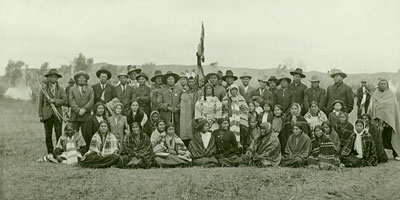
Prize Winners at the Indian Fair, Elbowoods, ND, 1911 SHSND# C0020-2In 1911, there were two significant events at Fort Berthold. The farm supervisor decided that crops should be limited to corn, potatoes, and garden vegetables. This decision provided gardeners with official support that appears to have been lacking earlier. While most women had continued to garden, their activity was de-valued by federal agents until 1911. In that year, the agency sponsored the first Fort Berthold Fair. The activities included displays of traditional and non-traditional garden vegetables. Buffalo Bird Woman entered corn in the fair and won first prize for her entry. (Independence, p. 201-202)
In common with the communal practices of pioneer gardeners (and modern gardeners), the Hidatsa shared the work of gardening and the produce with those who were in need. Buffalo Bird Woman spoke of how a woman who was sick at planting time would invite members of her society to her house, offered them a meal, and ask if they would plant for her. Each woman would pledge to plant a row, and if she finished quickly would plant another row, and so on until the planting was done. (Buffalo Bird Woman, p. 24)
Though Europeans had been aware of Indian crops as early as the mid-18th century, few saw these crops as having potential for commodity agriculture or home gardens. However, federal agents on reservations on the Great Plains found that eastern corn varieties would not mature on poor reservation soil and without sufficient rainfall. The Red Cloud agency in northwest Nebraska requested “Ree” (short for Arikara) corn in 1873 and found that it would grow where other varieties would not. Pioneers still avoided “squaw corn” in spite of the evidence of success. (Will, Corn, p. 20-21)




